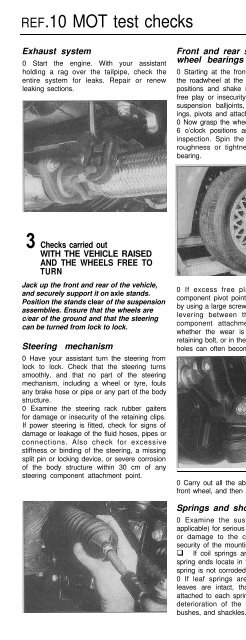Contents - Volkspage
Contents - Volkspage
Contents - Volkspage
You also want an ePaper? Increase the reach of your titles
YUMPU automatically turns print PDFs into web optimized ePapers that Google loves.
REF.10 MOT test checks<br />
Exhaust system<br />
0 Start the engine. With your assistant<br />
holding a rag over the tailpipe, check the<br />
entire system for leaks. Repair or renew<br />
leaking sections.<br />
Front and rear suspension and<br />
wheel bearings<br />
0 Starting at the front right-hand side, grasp<br />
the roadwheel at the 3 o’clock and 9 o’clock<br />
positions and shake it vigorously. Check for<br />
free play or insecurity at the wheel bearings,<br />
suspension balljoints, or suspension mountings,<br />
pivots and attachments.<br />
0 Now grasp the wheel at the 12 o’clock and<br />
6 o’clock positions and repeat the previous<br />
inspection. Spin the wheel, and check for<br />
roughness or tightness of the front wheel<br />
bearing.<br />
0 The same general checks apply to vehicles<br />
fitted with other suspension types, such as<br />
torsion bars, hydraulic displacer units, etc.<br />
Ensure that all mountings and attachments are<br />
secure, that there are no signs of excessive<br />
wear, corrosion or damage, and (on hydraulic<br />
types) that there are no fluid leaks or damaged<br />
pipes.<br />
0 Inspect the shock absorbers for signs of<br />
serious fluid leakage. Check for wear of the<br />
mounting bushes or attachments, or damage<br />
to the body of the unit.<br />
Driveshafis<br />
(fwd vehicles only)<br />
q Rotate each front wheel in turn and inspect<br />
the constant velocity joint gaiters for splits or<br />
damage. Also check that each driveshaft is<br />
straight and undamaged.<br />
3 Checks carried out<br />
WITH THE VEHICLE RAISED<br />
AND THE WHEELS FREE TO<br />
TURN<br />
Jack up the front and rear of the vehicle,<br />
and securely support it on axle stands.<br />
Position the stands clear of the suspension<br />
assemblies. Ensure that the wheels are<br />
c/ear of the ground and that the steering<br />
can be turned from lock to lock.<br />
Steering mechanism<br />
0 Have your assistant turn the steering from<br />
lock to lock. Check that the steering turns<br />
smoothly, and that no part of the steering<br />
mechanism, including a wheel or tyre, fouls<br />
any brake hose or pipe or any part of the body<br />
structure.<br />
0 Examine the steering rack rubber gaiters<br />
for damage or insecurity of the retaining clips.<br />
If power steering is fitted, check for signs of<br />
damage or leakage of the fluid hoses, pipes or<br />
connections. Also check for excessive<br />
stiffness or binding of the steering, a missing<br />
split pin or locking device, or severe corrosion<br />
of the body structure within 30 cm of any<br />
steering component attachment point.<br />
0 If excess free play is suspected at a<br />
component pivot point, this can be confirmed<br />
by using a large screwdriver or similar tool and<br />
levering between the mounting and the<br />
component attachment. This will confirm<br />
whether the wear is in the pivot bush, its<br />
retaining bolt, or in the mounting itself (the bolt<br />
holes can often become elongated).<br />
0 Carry out all the above checks at the other<br />
front wheel, and then at both rear wheels.<br />
Springs and shock absorbers<br />
0 Examine the suspension struts (when<br />
applicable) for serious fluid leakage, corrosion,<br />
or damage to the casing. Also check the<br />
security of the mounting points.<br />
q If coil springs are fitted, check that the<br />
spring ends locate in their seats, and that the<br />
spring is not corroded, cracked or broken.<br />
0 If leaf springs are fitted, check that all<br />
leaves are intact, that the axle is securely<br />
attached to each spring, and that there is no<br />
deterioration of the spring eye mountings,<br />
bushes, and shackles.<br />
Braking system<br />
0 If possible without dismantling, check<br />
brake pad wear and disc condition. Ensure<br />
that the friction lining material has not worn<br />
excessively, (A) and that the discs are not<br />
fractured, pitted, scored or badly worn (B).<br />
0 Examine all the rigid brake pipes<br />
underneath the vehicle, and the flexible<br />
hose(s) at the rear. Look for corrosion, chafing<br />
or insecurity of the pipes, and for signs of<br />
bulging under pressure, chafing, splits or<br />
deterioration of the flexible hoses.<br />
q Look for signs of fluid leaks at the brake<br />
calipers or on the brake backplates. Repair or<br />
renew leaking components.<br />
0 Slowly spin each wheel, while your<br />
assistant depresses and releases the<br />
footbrake. Ensure that each brake is operating<br />
and does not bind when the pedal is released.

















